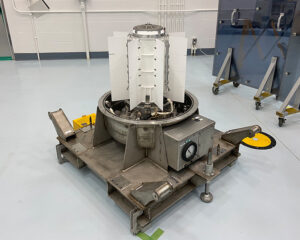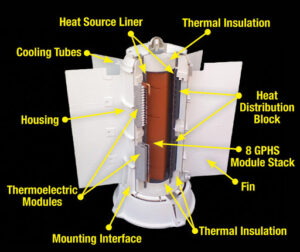Updated 5 March 2021
Peter Lobner
Radioisotope Thermoelectric Generators (RTG), also called Radioisotope Power Systems (RTS), commonly use non-weapons grade Plutonium 238 (Pu-238) to generate electric power and heat for National Aeronautics and Space Administration (NASA) spacecraft when solar energy and batteries are not adequate for the intended mission. In comparison to other RTG heat sources (Strontium-90, Cesium-137), Pu-238 has a relatively long half-life of 87.75 years, which is a desirable property for a long-life RTG.
Approximately 300 kg (661 lb) of Pu-238 was produced by the Department of Energy (DOE) at the Savannah River Site between 1959 – 1988. After U.S production stopped, the U.S. purchased Pu-238 from Russia until that source of supply ended in 2010.
Limited production of new Pu-238 in the U.S re-started in 2013 using the process shown below. This effort is partially funded by NASA. Eventually, production capacity will be about 1.5 kg (3.3 lb) Pu-238 per year. The roles of the DOE national laboratories involved in this production process are as follows:
- Idaho National Engineering Lab (INEL):
- Store the Neptunium dioxide (NpO2) feed stock
- Deliver feed stock as needed to ORNL
- Irradiate targets provided by ORNL in the Advanced Test Reactor (ATR)
- Return irradiated targets to ORNL for processing
- Oak Ridge National Lab (ORNL):
- Manufacture targets
- Ship some targets to INEL for irradiation
- Irradiate the remaining targets in the High Flux Isotope Reactor (HFIR)
- Process all irradiated targets to recover and purify Pu-238
- Convert Pu-238 to oxide and deliver as needed to LANL
- Los Alamos National Lab (LANL):
- Manufacture the Pu-238 fuel pellets for use in RTGs
Source: Ralph L McNutt, Jr, Johns Hopkins University APL, 2014
In 2015, the U.S. had an existing inventory of about 35 kg (77 lb) of Pu-238 of various ages. About half was young enough to meet the power specifications of planned NASA spacecraft. The remaining stock was more than 20 years old, has decayed significantly since it was produced, and did not meet specifications. The existing inventory will be blended with newly produced Pu-238 to extend the usable inventory. To get the energy density needed for space missions while extending the supply of Pu-238, DOE and NASA plan to blend “old” Pu-238 with newly produced Pu-238 in 2:1 proportions.
Since 2010, NASA’s RTG for spacecraft missions has been the Multi-Mission Radioisotope Thermoelectric Generator (MMRTG), which It is based on the SNAP-19 RTG flown on the two Viking Mars landers (circa 1975) and the Pioneer 10 and 11 deep space probes (circa 1972). At beginning of life, the current MMRTG can provide about 2,000 watts of thermal power and 110 watts of electrical power from eight General Purpose Heat Source (GPHS) modules that contain a total of 10.6 pounds (4.8 kilograms) of plutonium dioxide fuel. Electric conversion efficiency is about 6%.

Assembled MMRTG on a transport dolly. Source: NASA

MMRTG cut-away diagram. Source: NASA
You’ll find a NASA MMRTG Fact Sheet here: https://rps.nasa.gov/resources/86/multi-mission-radioisotope-thermoelectric-generator-mmrtg/?category=fact_sheets
NASA had a program to develop an Advanced Stirling Radioisotope Generator (ASRG), which was designed to produce about four times the power of the MMRTG per unit of Pu-238. Electric conversion efficiency was about 26%. The ASRG required a total of 2.7 pounds (1.2 kilograms) of plutonium dioxide in two GPHS modules. However, the ASRG would produce less waste heat, which can be used productively to warm electronics in the interior of a spacecraft, such as the Mars rover Curiosity. In November 2013, NASA announced that ASRG development had been discontinued because of budget cuts. You’ll find a NASA ASRG Fact Sheet at the following link: https://rps.nasa.gov/resources/65/advanced-stirling-radioisotope-generator-asrg/
You can read a history of RTGs and more information on current U.S. Pu-238 production status in a 2014 presentation by Ralph L McNutt, Jr, at the following link: https://www.lpi.usra.edu/sbag/meetings/jan2014/presentations/08_1545_McNutt_Pu238_SBAG.pdf
9 February 2016 Update:
On 22 December 2015, DOE reported the first U.S. production in nearly 30 years of Pu-238. This production demonstration, which was partially funded by the NASA, was performed at ORNL and yielded 50 grams of Pu-238. The last U.S. production of Pu-238 occurred in the late 1980s at the Savannah River Plant in South Carolina.
DOE reported that it plans to set an initial production target of 300 – 400 grams (about 12 ounces) of Pu-238 per year. After implementing greater automation and scaling up the process, ORNL expects to reach the the production target of 1.5 kg (3.3 lb) Pu-238 per year.
The next NASA mission that will use an RTG is the Mars 2020 rover, which will use an MMRTG, as used on NASA’s Mars rover Curiosity.
You can read the ORNL announcement of initial Pu-238 production at the following link: https://www.ornl.gov/news/ornl-achieves-milestone-plutonium-238-sample
3 January 2019 Update:
In the past three years, ORNL has made scant progress in producing Pu-238. In a 13 December 2018 article, “NASA Doesn’t Have Enough Nuclear Fuel For Its Deep Space Missions,”author Ethan Siegel reports: “Although current production (at ORNL) yields only a few hundred grams per year (less than a pound), the laboratory has the eventual goal of ramping up to 1.5 kilograms (3.3 pounds) per year by 2023, at the earliest. Ontario Power Generation in Canada has also begun producing Pu-238, with the goal of using it as a supplemental source for NASA.” You can read the complete article on the Forbes website at the following link: https://www.forbes.com/sites/startswithabang/2018/12/13/nasa-doesnt-have-enough-nuclear-fuel-for-its-deep-space-missions/#1a73d47e1c18
The Canadian plans for becoming a source of Pu-238 was announced on 1 March 2017: “Ontario Power Generation (OPG) and its venture arm, Canadian Nuclear Partners, are participating in a project to produce isotopes in support of deep space exploration. Under the agreement, OPG would help create isotopes at the Darlington nuclear station east of Toronto that will help power space probes.” You can read the complete OPG press release here: https://www.opg.com/news-and-media/news-releases/Documents/20170301_DeepSpace.pdf
Also see the OPG public relations piece, “OPG looks to the stars,” here: https://www.opg.com/news-and-media/our-stories/Documents/20170802_OPG_Deep_Space.pdf
4 August 2020 Update:
The NASA Mars rover, Perseverance, was launched from Cape Canaveral on 30 July 2020, with an expected landing date of 18 February 2021 in the Jezero crater on Mars. Once on the surface, Perseverance will be powered by an MMRTG.
The Pu-238 and some other special materials for the Perseverence MMRTG were produced in the U.S. at ORNL, as described in the following short (2:03 minutes) video, “ORNL-produced tech fuels NASA’s Perseverance mission to Mars”:
In a 20 July 2020 news release, ORNL provided more information on the U.S. production process for Pu-238 and reported that, “the lab has been consistently increasing its Pu-238 production capabilities, aiming to produce 1.5 kilograms per year by 2026.” You can read this ORNL press release here: https://www.ornl.gov/news/ornl-produced-plutonium-238-help-power-perseverance-mars
At the planned U.S. production rate for Pu-238, NASA should be able to conduct an MMRTG mission at about four-year intervals. If NASA MMRTG missions will be more frequent than this, the U.S. will need to purchase additional Pu-238 from another source, perhaps Canada.
5 March 2021 Update:
The Perseverance rover landed on Mars on 18 February 2021, in the planned target area in Jezero Crater. Power from the MMRTG was nominal after landing. Perseverance will spend at least one Mars year (two Earth years) exploring the landing site region.
The next NASA mission with an MMRTG-powered spacecraft is the Dragonfly mission to Saturn’s moon Titan, which will launch in 2026 and arrive on Titan in 2034.
The Voyager 1 and 2 spacecraft were launched in 1977, each with three RTGs delivering a maximum of 470 watts of electrical power at the beginning of the mission. Both spacecraft have left the solar system (Voyager 1 in 2013 and Voyager 2 in 2018) and continue to transmit from interstellar space in 2021 with their RTGs operating at a reduced power level of about 331 watts after 44 years of Pu-238 decay during the mission. NASA plans to continue the Voyager missions until at least 2025.
For more information:
- “Plutonium-238 Production for Space Exploration – A National Historic Chemical Landmark,” American Chemical Society: https://www.acs.org/content/acs/en/education/whatischemistry/landmarks/plutonium-238-production.html
- Plutonium (Pu) 238 Radioactive Isotope Decay Calculator: https://www.easycalculation.com/chemistry/Pu-238.html
